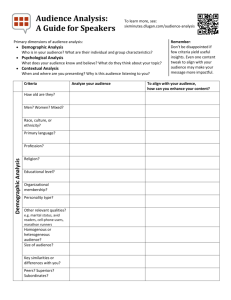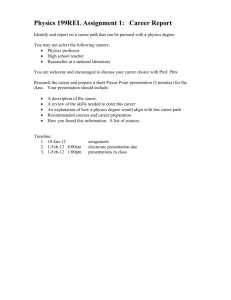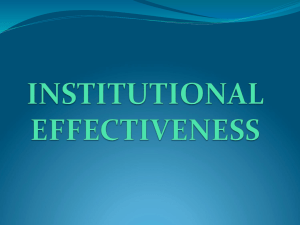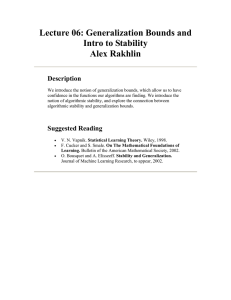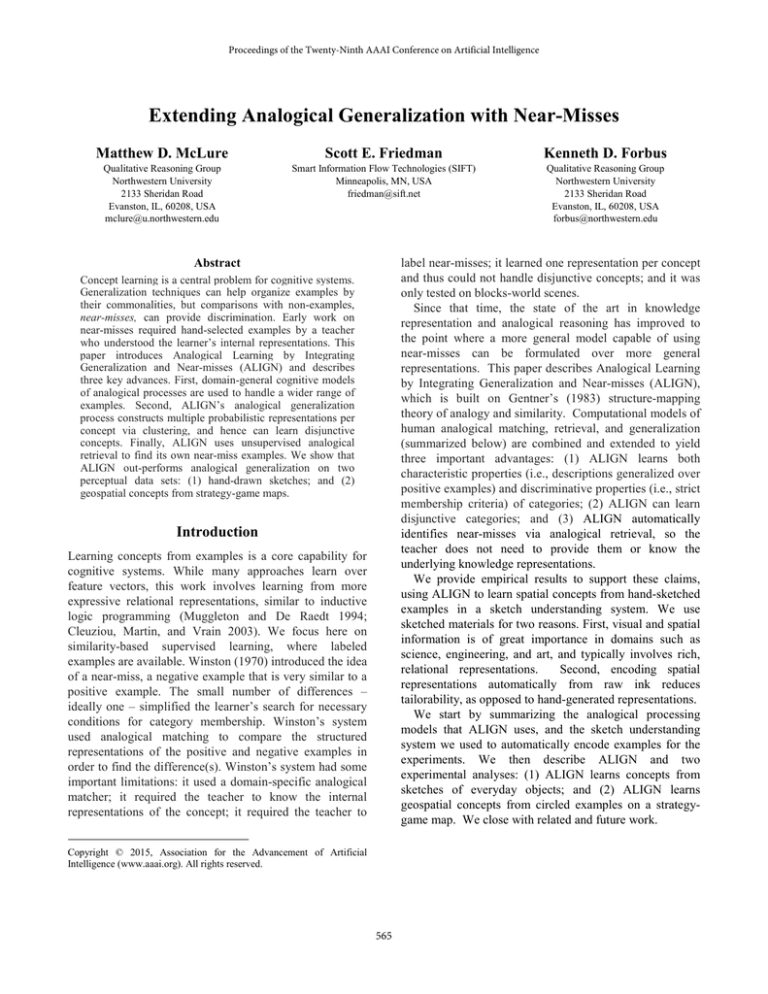
Proceedings of the Twenty-Ninth AAAI Conference on Artificial Intelligence
Extending Analogical Generalization with Near-Misses
Matthew D. McLure
Scott E. Friedman
Kenneth D. Forbus
Qualitative Reasoning Group
Northwestern University
2133 Sheridan Road
Evanston, IL, 60208, USA
mclure@u.northwestern.edu
Smart Information Flow Technologies (SIFT)
Minneapolis, MN, USA
friedman@sift.net
Qualitative Reasoning Group
Northwestern University
2133 Sheridan Road
Evanston, IL, 60208, USA
forbus@northwestern.edu
label near-misses; it learned one representation per concept
and thus could not handle disjunctive concepts; and it was
only tested on blocks-world scenes.
Since that time, the state of the art in knowledge
representation and analogical reasoning has improved to
the point where a more general model capable of using
near-misses can be formulated over more general
representations. This paper describes Analogical Learning
by Integrating Generalization and Near-misses (ALIGN),
which is built on Gentner’s (1983) structure-mapping
theory of analogy and similarity. Computational models of
human analogical matching, retrieval, and generalization
(summarized below) are combined and extended to yield
three important advantages: (1) ALIGN learns both
characteristic properties (i.e., descriptions generalized over
positive examples) and discriminative properties (i.e., strict
membership criteria) of categories; (2) ALIGN can learn
disjunctive categories; and (3) ALIGN automatically
identifies near-misses via analogical retrieval, so the
teacher does not need to provide them or know the
underlying knowledge representations.
We provide empirical results to support these claims,
using ALIGN to learn spatial concepts from hand-sketched
examples in a sketch understanding system. We use
sketched materials for two reasons. First, visual and spatial
information is of great importance in domains such as
science, engineering, and art, and typically involves rich,
relational representations.
Second, encoding spatial
representations automatically from raw ink reduces
tailorability, as opposed to hand-generated representations.
We start by summarizing the analogical processing
models that ALIGN uses, and the sketch understanding
system we used to automatically encode examples for the
experiments. We then describe ALIGN and two
experimental analyses: (1) ALIGN learns concepts from
sketches of everyday objects; and (2) ALIGN learns
geospatial concepts from circled examples on a strategygame map. We close with related and future work.
Abstract
Concept learning is a central problem for cognitive systems.
Generalization techniques can help organize examples by
their commonalities, but comparisons with non-examples,
near-misses, can provide discrimination. Early work on
near-misses required hand-selected examples by a teacher
who understood the learner’s internal representations. This
paper introduces Analogical Learning by Integrating
Generalization and Near-misses (ALIGN) and describes
three key advances. First, domain-general cognitive models
of analogical processes are used to handle a wider range of
examples. Second, ALIGN’s analogical generalization
process constructs multiple probabilistic representations per
concept via clustering, and hence can learn disjunctive
concepts. Finally, ALIGN uses unsupervised analogical
retrieval to find its own near-miss examples. We show that
ALIGN out-performs analogical generalization on two
perceptual data sets: (1) hand-drawn sketches; and (2)
geospatial concepts from strategy-game maps.
Introduction
Learning concepts from examples is a core capability for
cognitive systems. While many approaches learn over
feature vectors, this work involves learning from more
expressive relational representations, similar to inductive
logic programming (Muggleton and De Raedt 1994;
Cleuziou, Martin, and Vrain 2003). We focus here on
similarity-based supervised learning, where labeled
examples are available. Winston (1970) introduced the idea
of a near-miss, a negative example that is very similar to a
positive example. The small number of differences –
ideally one – simplified the learner’s search for necessary
conditions for category membership. Winston’s system
used analogical matching to compare the structured
representations of the positive and negative examples in
order to find the difference(s). Winston’s system had some
important limitations: it used a domain-specific analogical
matcher; it required the teacher to know the internal
representations of the concept; it required the teacher to
Copyright © 2015, Association for the Advancement of Artificial
Intelligence (www.aaai.org). All rights reserved.
565
SME to compare the probe to each MAC result, in parallel.
The case with highest SME similarity score, plus up to two
more if very close to the top scorer, are returned as the
reminding(s).
Background
Computational models of Structure-Mapping
Structure-Mapping is a psychological theory of analogy
and similarity that has been used to explain how people
compare visual stimuli (Markman and Gentner 1996; Sagi,
Gentner, and Lovett 2012), learn abstract categories
(Gentner and Namy 1999), and learn contrastive categories
via difference detection (Smith and Gentner 2014). It
defines analogical comparison as a process of aligning two
structured representations, a base and a target, guided by
mapping constraints. The matching process produces
correspondences that specify which elements (i.e., entities
and expressions) in the base go with which elements in the
target. Structure-mapping also generates candidate
inferences that project unshared structure (i.e., noncorresponding expressions) from base to target or viceversa.
Sequential Analogical Generalization Engine (SAGE)
The Sequential Analogical Generalization Engine (SAGE)
is a model of analogical generalization built on SME, and
the successor to SEQL (Kuehne et al. 2000). SAGE
maintains a generalization context for each concept, where
incoming training examples are incrementally clustered to
form generalizations (two or more analogically mapped
examples) and unassimilated examples (clusters of size
one). SAGE generalizations are themselves cases, but each
expression in a generalization is assigned a probability
based on the frequency with which it corresponded to
expressions in co-clustered examples.
The Structure-Mapping Engine (SME)
The Structure-Mapping Engine (Falkenhainer, Forbus, and
Gentner 1989) is a computational model of structuremapping theory. SME operates via a local-to-global
process, initially constructing local match hypotheses in
parallel, followed by a serial phase that greedily coalesces
islands of matches into globally consistent mappings,
guided by a scoring process based on structure-mapping
principles. Each mapping contains a set of correspondences
and a similarity score that captures the overall similarity.
The similarity score is normalized to the closed interval [0,
1] by dividing by the mean of the scores of the selfmatches of base and target. Each mapping can contain
candidate inferences, from base to target, and reverse
candidate inferences, from target to base. Candidate
inferences can include analogy skolems, which are entities
hypothesized via projection because they lack a
correspondent in the other case.
Figure 1: An example is added to the “Arch” generalization
context and generalized with a previously unassimilated
example.
The SAGE algorithm consists of two stages: (1) select at
most one existing cluster that is sufficiently similar to the
incoming example, and (2) merge the incoming example
into the cluster, if sufficiently similar. The select process
uses MAC/FAC, with the new example as the probe and
the generalization context as the case library. If the
normalized similarity score of the best reminding is greater
than the assimilation threshold of the generalization
context, SAGE merges the example; otherwise, the new
example is added as an unassimilated example.
The merge process uses the correspondences in the SME
mapping to (1) update the probabilities associated with
each existing expression in the generalization, and (2) add
new expressions from the example to the generalization.
When non-identical entities correspond in the mapping,
SAGE replaces them with generalized entities (i.e.,
symbols that represent multiple symbols from examples).
A merge is illustrated in Figure 1, where corresponding
expressions in the resulting generalization have p = 1.0,
and non-corresponding expressions have a p = 0.5. SME
uses these probabilities to bias the local scores on match
MAC/FAC
MAC/FAC (Forbus, Gentner, and Law 1995) is a model of
similarity-based retrieval built on SME. The inputs are (1)
a probe case and (2) a set of cases from which to retrieve,
called a case library. MAC/FAC retrieves up to three
similar cases from the case library based on similarity to
the probe. The algorithm has two stages. The first stage
(MAC) computes in parallel coarse similarity estimates
between the probe and every case in the case library using
content vectors, a redundant non-structured representation
computed from the cases. Each dimension in a content
vector is proportional to the number of statements using
that predicate in the original case, thus the dot product
estimates the number of local matches that SME will find
between the probe and each case. This scales well to large
case libraries. The cases with the highest dot product with
the probe are passed to the second stage, FAC. FAC uses
566
Figure 2: Three pairs of sketched objects with decreasing
normalized similarity scores, from top to bottom. All three
pairs are potential near-misses because their labels differ.
Figure 3: A water glyph (top-left) is decomposed into its
skeleton edges (bottom right) by using a grassfire algorithm
(top-right) to compute a medial-axis transform, which is
pruned and segmented according to its radius function.
hypotheses. As SAGE assimilates more examples into a
generalization, some expressions will retain high
probability, while others will diminish. Consequently,
generalizations in SAGE express a probability distribution
over their expressions, separating characteristic (high
probability) structure from incidental (low-probability)
structure. SAGE uses a probability threshold to prune
low-probability expressions from the generalization and
maintain tractability.
SAGE has been used to learn and classify musical
genres (Dehghani and Lovett 2006), spatial prepositions
(Lockwood, Lovett, and Forbus 2008), and sketched everyday objects (Lovett, Dehghani, and Forbus 2007; McLure,
Friedman, and Forbus 2012), suggesting that it provides a
domain-general foundation for ALIGN.
for adjacency, relative position and size, and topological
relationships. It is capable of analyzing the same sketch at
multiple levels of description (i.e., edges, objects, and
groups).
CogSketch interacts with the strategy game Freeciv to
encode qualitative structured representations for regions on
the map. CogSketch renders the map and creates glyphs for
units, cities, and terrain blobs (i.e., polygons that outline
groups of tiles that share some property). The user selects a
region by drawing a glyph on the map (e.g., the red circle
in Figure 3). When the user assigns a conceptual label to
the selection glyph, CogSketch automatically encodes a
case. The encoding scheme used in our geospatial
classification task (illustrated in Figure 3) begins by
detecting and recording topological relationships between
the selection glyph and overlapping land or water terrain
blobs. Any blob glyph that overlaps the selection glyph is
decomposed into a skeleton based on the Medial Axis
Transform (MAT). Each skeleton is further segmented at
points corresponding to qualitative changes in the radius
function (i.e., the distance from each point to its closest
points on the exterior) – a strategy inspired by shock
graphs (Siddiqi et al. 1999). The result for each blob glyph
is a network of edges directed from its wider sections to its
narrower sections. The scheme encodes qualitative
properties over these edges including length, radius
function, curvature, and various aspects of connectivity.
Finally, topological relationships between each edge and
the selection glyph are encoded.
CogSketch has been used to model visual problem
solving (Lovett, Forbus, and Usher 2010), including
CogSketch
Sketching is a powerful way to express visual and spatial
ideas. CogSketch (Forbus et al. 2011) is an open-domain
sketch understanding system. Users draw digital ink, which
they segment into visual entities (glyphs) and label with
concepts drawn from a large (OpenCyc-derived)
knowledge base.1 Conceptual labeling is a practical
vehicle for information that is often conveyed with
language during human-to-human sketching (e.g., “this is a
block”). CogSketch constructs visual representations from
what is drawn (e.g., that two glyphs have intersecting
edges) and spatial representations from both the visual and
conceptual information (e.g., that the objects depicted by
the glyphs are touching). Figure 2 shows six examples.
CogSketch’s extensive vocabulary of representations is
motivated by human spatial cognition, including relations
1
www.cyc.com/platform/opencyc
567
cultural differences (Lovett and Forbus 2011). It has also
been used as a platform for sketch-based educational
software (Yin et al. 2010). These experiments suggest that
the representations it produces are both realistic and useful.
2. Negative-to-positive CIs (NPCIs) project relations from
the negative example, in terms of the positive
example’s entities. ALIGN converts these to exclusion
hypotheses: sufficient criteria for blocking category
membership.
ALIGN associates hypotheses with the positive example,
and represents hypotheses in terms of the positive
example’s entities. For PNCIs, this requires a translation
step that replaces the entities mentioned (from the negative
side) with their corresponding (positive) entities. In Figure
4 (top), H1 is an inclusion hypothesis for the category arch
resulting from the PNCI (isa e Block), and H3 is an
exclusion hypothesis resulting from the NPCI (touches
f g).
ALIGN also represents skolems in its hypotheses. A
skolem in a PNCI is replaced with the positive entity from
which it was projected, e.g. (AnalogySkolemFn m)
translates to m. In contrast, NPCIs with skolems result in
more complex exclusion hypotheses, because they need to
ALIGN
Similarity can be deceptive. Isthmuses are similar to straits,
bays are similar to peninsulas, and bridges are similar to
arches. In this section, we describe how ALIGN leverages
these deceptive similarities as opportunities to learn and
represent category boundaries. We begin by discussing
how ALIGN detects and exploits deceptive similarities,
then we describe how it represents and revises its
hypotheses, and finally we describe how it classifies
examples with a mix of similarity and hypothesis-testing.
Detecting & Exploiting Near-Misses with Analogy
Given a labeled training example (e.g., of an arch),
ALIGN uses MAC/FAC to retrieve similar training
examples with different labels (e.g., bridge) or a null label.2
High-similarity pairs of examples with different labels
above a similarity threshold (equal to SAGE’s assimilation
threshold) are near-misses. Using the best SME mapping
between the positive (arch) and negative (bridge or null)
example, ALIGN uses the candidate inferences (i.e.,
projected expressions across cases) to produce hypotheses
about category boundaries.
ALIGN distinguishes between two types of candidate
inferences (CIs) that produce different hypotheses:
1. Positive-to-negative CIs (PNCIs) project relations from
the positive example in terms of the negative
example’s entities. ALIGN converts these to inclusion
hypotheses: necessary criteria for asserting category
membership.
CL = {} ;; a case library for training examples
;; S = similarity threshold, MYX = reverse mapping of MXY
TrainOn(example P, label LP) ;; label may be null
if LP
GCP = Label→GeneralizationContext (LP)
{GP, MGP} = SageAdd (P, GCP, S) ;; if unassimilated,
;; GP=P & MGP=null
for each {N, MNP} in MacFacRetrieve(P,CL)
LN = Example→Label(N)
{GN, MGN} = Example→Generalization (N)
if LP ≠ LN and NormScore(MNP) > S ;; a near-miss
GenerateNewCriteria(LP, GP, P, N, MNP, MPG)
GenerateNewCriteria(LN, GN, N, P, MPN, MNG)
CL = CL + P
GenerateNewCriteria(label L, gen G, pos P, neg N,
mapping MNP, mapping MPG)
if L and not BlockedByCriteria(N, G, MGP, MPN)
HPL = ExtractCriteria(P, L, MNP)
AddCriteria(G, GeneralizeCriteria(HPL, MPG))
TestOn(unlabeled example U)
D = {} ;; discarded remindings
for 1 to 3
R = MacFacRetrieve(U, (CL – D))
for each {E, MEU} in SortByGenSimilarity(R, U)
LE = Example→Label(E)
{GE, MGE} = Example→Generalization(E)
if BlockedByCriteria(U, GE, MGE, MEU)
D=D+E
else return LE
return Example→Label(LeastBlocked(D))
Figure 4: A near-miss pair and hypothesis revision
Figure 5: ALIGN’s top-level training and testing procedures.
2
In this paper, categories are mutually exclusive, and some training and
testing examples have a null label (i.e., they are confusers).
568
for their associated generalizations. Starting with the most
similar case, ALIGN tests each of the case’s associated
hypotheses by:
1. Translating the hypothesis to refer to entities in the
unlabeled example, using the entity correspondences
of the best mapping.
2. Testing whether the translated condition holds. If an
exclusion hypothesis holds or an inclusion hypothesis
fails to hold (skolems count as failures), do not infer
that label.
If these hypotheses are consistent with the new example,
ALIGN classifies the new example with the retrieved label.
Otherwise, ALIGN iterates to the next retrieved example.
This is important for distinguishing similar categories.
Because we assume that the set of concepts is
collectively exhaustive, ALIGN conducts repeated
retrievals during classification until it finds an unblocked
label. If no unblocked label is found after 3 retrievals, then
the label of the most highly supported retrieval is chosen.
Support is determined by subtracting the cumulative
weight of the inconsistent hypotheses from that of the
consistent hypotheses. Since null-labeled retrievals cannot
have associated hypotheses, they have neutral (0) support.
specify criteria about extra entities that aren’t represented
in the positive case while remaining embedded in the case.
For these NPCIs, ALIGN replaces each skolem with a
variable, and constrains each variable so that it cannot bind
to any entity from the positive example that entered into
the near-miss mapping. Thus, a NPCI such as (touches
j (AnalogySkolemFn x)) is translated to capture the
hypothesis that there cannot be something extra that
touches j, as follows (cannot is implicit because it is an
exclusion hypothesis):
(and (different
(different
(different
(different
(touches j
i ?skolem)
j ?skolem)
k ?skolem)
l ?skolem)
?skolem))
ALIGN discards near-miss pairs that are explained away
by existing hypotheses associated with the positive
example.
In practice, hypotheses produced from a single
comparison can be over-specific, and must be revised to be
practically useful. We describe this process next.
Revising Hypotheses with Analogical Generalization
ALIGN maintains one SAGE generalization context for
every (non-null) label encountered, and each training
example is added to the generalization context
corresponding to its label, if any. If SAGE assimilates the
example into a generalization, its associated hypotheses are
generalized to refer to the entities in the generalization.
Generalized hypotheses are pruned if they include
conditions not true of all examples assimilated into the
generalization (i.e., expressions with p < 1.0 for inclusion
hypotheses, and p > 0 for exclusion hypotheses). Figure 4
(bottom) demonstrates pruning an inclusion hypothesis.
ALIGN uses generalized hypotheses to block labels and
explain away new near-misses. An extra analogical
translation step is required to project these hypotheses from
the generalization to an unlabeled or negative example, via
the positive (assimilated) example. The degree to which a
failed hypothesis blocks a label is weighted using the size
of the generalization it is associated with, with the intuition
being that hypotheses that persist after more generalization
operations are more accurate, all else being equal.
Since SAGE can produce multiple clusters from the
positive examples of a single concept, ALIGN can
maintain alternative sets of hypotheses for a given concept,
resulting in a disjunctive category structure. Structural
similarity (via analogical retrieval) determines which
disjunct(s) get tested against a given unlabeled example.
Evaluation
To evaluate the extension of analogical generalization with
near-misses, we ran two classification tasks under different
conditions: (1) ALIGN is the full system described above;
(2) Prototypes is ALIGN without near-miss analysis; and
(3) Examples is ALIGN without near-misses and also
without analogical generalization, so classification is
reduced to similarity-based retrieval over the library of
training examples. For moderately high similarity
thresholds (0.6-0.9), we expected Prototypes to outperform
Examples and ALIGN to outperform both.
Arches: 8
Bridges: 4 False arches: 8
Skeletal arms: 4
Triangles: 4 False triangles: 4
Skeletal legs: 4 Quadrilaterals: 4
False quads: 4
Table 1: A dataset of sketched concepts. “False” categories
were negative examples of all categories.
Experiment 1
ALIGN was compared with the Prototypes and Examples
conditions in a classification task involving objects
sketched in CogSketch. There were 44 sketches distributed
over 6 mutually exclusive labels, where 16 of the sketches
had null labels (i.e., no positive labels) but were potential
near-misses for some of the concepts (e.g., false arches are
nearly arches) as summarized in Table 1. The cases
produced by CogSketch each contained, on average, 4.5
Classification via Analogy
To classify an unlabeled example, ALIGN retrieves similar
labeled examples from memory. Those retrieved examples
that have been assimilated during learning are exchanged
569
Accuracy
validation was used. ALIGN was compared to the
Prototypes approach over a range of similarity thresholds.
At a threshold of 1, both reduce to Examples.
1
0.9
0.8
0.7
0.6
0.5
0.4
0.3
0.2
0.1
0
Chance
Examples
Prototypes
Results
As shown in Figure 7, ALIGN achieved a peak accuracy of
77%, significantly outperforming the Prototypes peak
performance of 62% (p < 0.05). The Prototypes condition
where similarity threshold (S) is 1 is by definition the
Examples condition, since S = 1 effectively prevents
generalization and near-miss analysis. Here, Examples
performed significantly worse than ALIGN with an
accuracy of 53% (p < 0.05), which was not significantly
different from the peak of Prototypes.
ALIGN
Figure 6: Classification performance of ALIGN compared to
Examples and Prototypes.
unique entities and 31 facts. The task was to choose one or
none of the 6 labels, with chance at 21% accuracy.
Performance was evaluated via 4-fold cross-validation.
Statistical significance was measured using a one-tailed,
paired t-test. The similarity threshold for ALIGN was set to
0.8. This was also the assimilation threshold used for the
Prototypes condition.
Discussion
This data demonstrates that extending analogical
generalization with near-misses can improve classification
for spatial concepts represented as structured, qualitative
descriptions. The interaction between the similarity
threshold and the marginal benefit of near-misses suggests
that there is a “sweet spot” for comparison; when the
threshold is too low, more distant near-miss comparisons
are generated, resulting in more hypotheses, most of which
are incidental differences and should be pruned. When the
similarity threshold is too high, the generalizations in
SAGE end up smaller in size and more numerous,
providing less basis for pruning bad hypotheses.
Using analogical generalization alone (Prototypes) did
not significantly improve performance over simple
retrieval (Examples) as we expected. The identical
performance in Experiment 1 is likely related to the size of
the categories; out of a group of four bridges, at least three
must be sufficiently similar for two to generalize in the
training set and a third to match with the resulting
prototype during classification. Also recall that Experiment
1 contains examples without any positive label, which are
not given a chance to generalize. Thus, their incidental
similarities to other categories are not suppressed.
Results
Figure 6 shows the results of Experiment 1. The Prototypes
and Examples approaches performed identically at 55%
accuracy, well above chance (p < 0.01). ALIGN
demonstrated a 7% improvement over these conditions (p
< 0.01).
Experiment 2
Accuracy
This experiment evaluated classification performance in a
task involving geospatial concepts. Examples were circled
on a Freeciv map using CogSketch as described above. The
dataset consisted of 60 examples evenly distributed over 6
mutually exclusive and collectively exhaustive categories:
Isthmus, Peninsula, Strait, Bay, Archipelago and Island.
The cases produced by CogSketch each contained, on
average, 8 unique entities and 60 facts. 10-fold crossChance
Prototypes
ALIGN
1
0.9
0.8
0.7
0.6
0.5
0.4
0.3
0.2
0.1
0
Related Work
0
0.1 0.2 0.3 0.4 0.5 0.6 0.7 0.8 0.9
ALIGN is capable of learning with relatively few
examples. It requires orders of magnitude fewer examples
than existing connectionist models (e.g., Elman 1998;
Krizhevsky, Sutskever, and Hinton 2012). We believe
ALIGN makes more realistic demands.
The IDeAL system (Bhatta and Goel 1997) learned by
analogy over structured representations similar to those
used by ALIGN, but it was applied to a design problemsolving task instead of recognition. Its retrieval mechanism
indexed previous designs by their function, whereas
retrieval in ALIGN uses domain-general similarity-based
1
Similarity Threshold (S)
Figure 7: Classification accuracy on a geospatial dataset.
570
Cleuziou, G., Martin, L., & Vrain, C., 2003. Disjunctive learning
with a soft-clustering method. In ILP’03: 13th International
Conference on Inductive Logic Programming, 75–92.
Elman, J., 1998. Generalization, simple recurrent networks, and
the emergence of structure. In Proceedings of the Twentieth
Annual Conference of the Cognitive Science Society. Mahwah,
NJ: Lawrence Erlbaum Associates.
Falkenhainer, B., Forbus, K., & Gentner, D., 1989. The structuremapping engine: Algorithm and examples. Artificial Intelligence
41(1), 1-63.
Forbus, K., Gentner, D., and Law, K., 1995. MAC/FAC: A model
of similarity-based retrieval. Cognitive Science 19, 141-205.
Forbus, K. D., Usher, J., Lovett, A., Lockwood, K. and Wetzel, J.,
2011. Cogsketch: Sketch understanding for cognitive science
research and for education. Topics in Cognitive Science 3.
Gaddam, S., Phoha, V., & Balagani, K., 2007. K-Means+ID3: A
novel method for supervised anomaly detection by cascading kmeans clustering and ID3 decision tree learning methods. IEEE
Transactions on Knowledge and Data Engineering 19(3).
Gentner, D., & Namy, L., 1999. Comparison in the development
of categories. Cognitive Development 14, 487-513.
Gentner, D., 1983. Structure-mapping: A theoretical framework
for analogy. Cognitive Science 7(2), 155-170.
Krizhevsky, A., Sutskever, I., and Hinton, G. E., 2012. Imagenet
classification with deep convolutional neural networks. Advances
in Neural Information Processing Systems, 1097-1105.
Kuehne, S., Forbus, K., Gentner, D. and Quinn, B., 2000. SEQL:
Category learning as progressive abstraction using structure
mapping. Proceedings of CogSci. 2000.
Lovett, A., Forbus, K., and Usher, J., 2010. A structure-mapping
model of Raven's Progressive Matrices. Proc. of CogSci 2010.
Lovett, A., & Forbus, K., 2011. Cultural commonalities and
differences in spatial problem solving: A computational analysis.
Cognition 121, 281-287.
Markman, A. B., & Gentner, D., 1996. Commonalities and
differences in similarity comparisons. Memory & Cognition
24(2), 235-249.
Muggleton, S., & De Raedt, L., 1994. Inductive logic
programming: Theory and methods. Journal of Logic
Programming 19-20, 629-679.
Sagi, E., Gentner, D., & Lovett, A., 2012. What difference reveals
about similarity. Cognitive Science 36, 1019-1050.
Siddiqi, K., Shokoufandeh, A., Dickinson, S. J., and Zucker, S.
W., 1999. Shock graphs and shape matching. International
Journal of Computer Vision 30, 1-24.
Smith, L., & Gentner, D., 2014. The role of difference-detection
in learning contrastive categories. Proceedings of CogSci. 2014.
Winston, P. H., 1970. Learning structural descriptions from
examples. Ph.D. diss., MIT, Cambridge, MA.
Winston, P. H., 1982. Learning new principles from precedents
and exercises. Artificial Intelligence 23(12).
Winston, P. H., 1986. Learning by augmenting rules and
accumulating censors. In Machine Learning: An Artificial
Intelligence Approach 2, 45-62. Morgan-Kaufman.
Yin, P., Forbus, K., Usher, J., Sageman, B. and Jee, B., 2010.
Sketch Worksheets: A Sketch-based Educational Software
System. Proceedings of the 22nd Annual Conference on
Innovative Applications of Artificial Intelligence.
retrieval. IDeAL learned generic teleological mechanisms
by comparing a correct solution provided by a teacher to
designs retrieved from memory – similar to near-miss
discovery in ALIGN – but it relied on design-specific
background knowledge to abstract the appropriate aspects
from the design pair. Hypothesis production in ALIGN is
domain-general, so instead it relies on finding similar
positive examples to properly refine its hypotheses.
Cleuziou, Martin and Vrain (2003) described an
inductive logic programming (ILP) approach to learning
disjunctive concepts that bore similarities to ALIGN.
Positive examples were clustered into subconcepts
according to a similarity measure, and a separate
conjunctive definition was learned for each subconcept
based on the negative examples. Its representations,
similarity metric, and hypothesis generation were all based
in first order logic; the rules learned contained logical
variables and were tested deductively, in contrast with the
hypotheses here, which are embedded in learned models
and tested via analogical projection. Winston (1982, 1986)
also explored learning rules from analogies, producing
logical rules via generalizing on one example. His if-then
rules and censors were functionally similar to our inclusion
and exclusion hypotheses, respectively.
Another analogous approach is K-Means+ID3 (Gaddam,
Phoha, and Balagani 2007), which cascaded k-means
clustering and ID3 decision trees for anomaly detection.
While their approach used feature-vector data, it shared the
idea that rule-based class boundaries can apply better when
trained locally in some similarity space.
Conclusions and Future Work
This paper describes ALIGN, a concept learning model
that extends analogical generalization with near-misses. It
is capable of automatically finding its own near-miss
examples, and we have shown evidence from two
experiments that near-misses significantly improve
performance over analogical generalization and retrieval
alone. We plan on experimenting with ALIGN in other
domains, as well as expanding the range of concepts in
sketched domains.
Acknowledgements
This material is based upon work supported by the Air
Force Office of Scientific Research under Award No.
FA2386-10-1-4128.
References
Bhatta, S., & Goel, A., 1997. Learning generic mechanisms for
innovative strategies in adaptive design. The Journal of the
Learning Sciences 6(4), 367-396.
571

